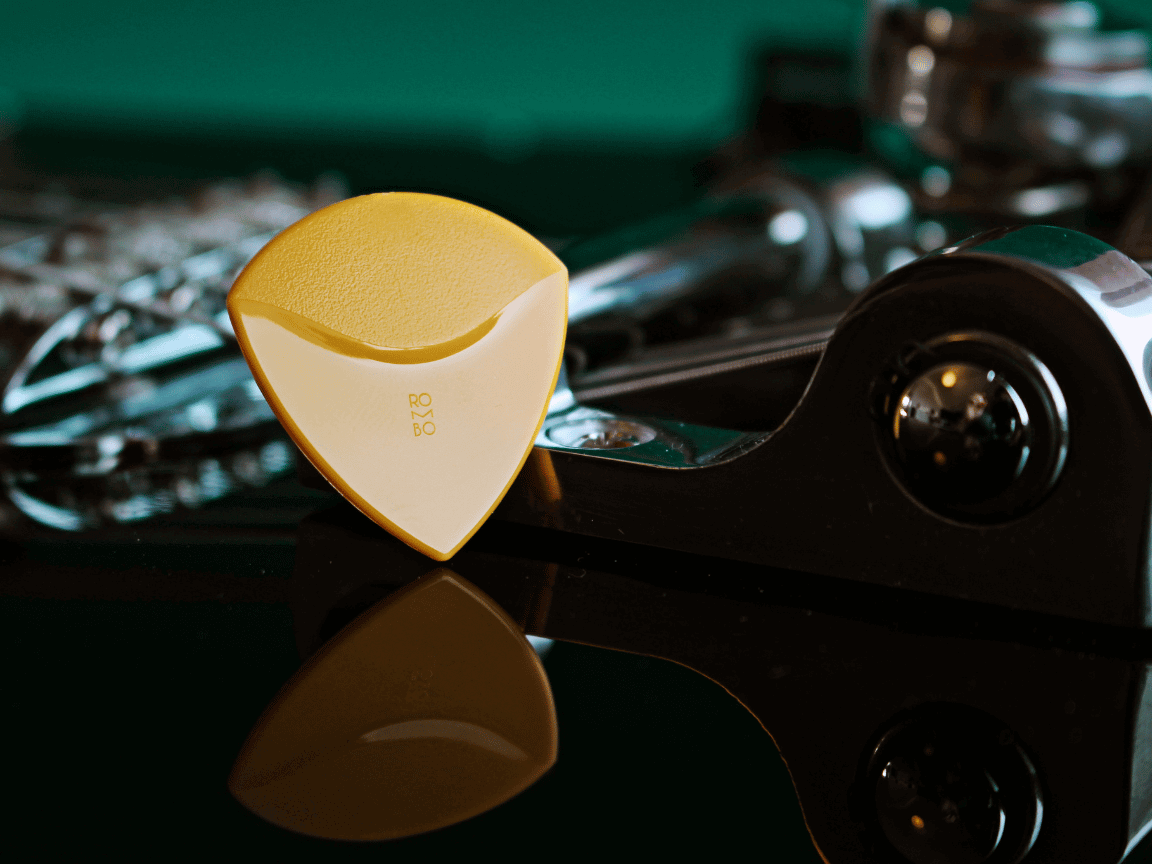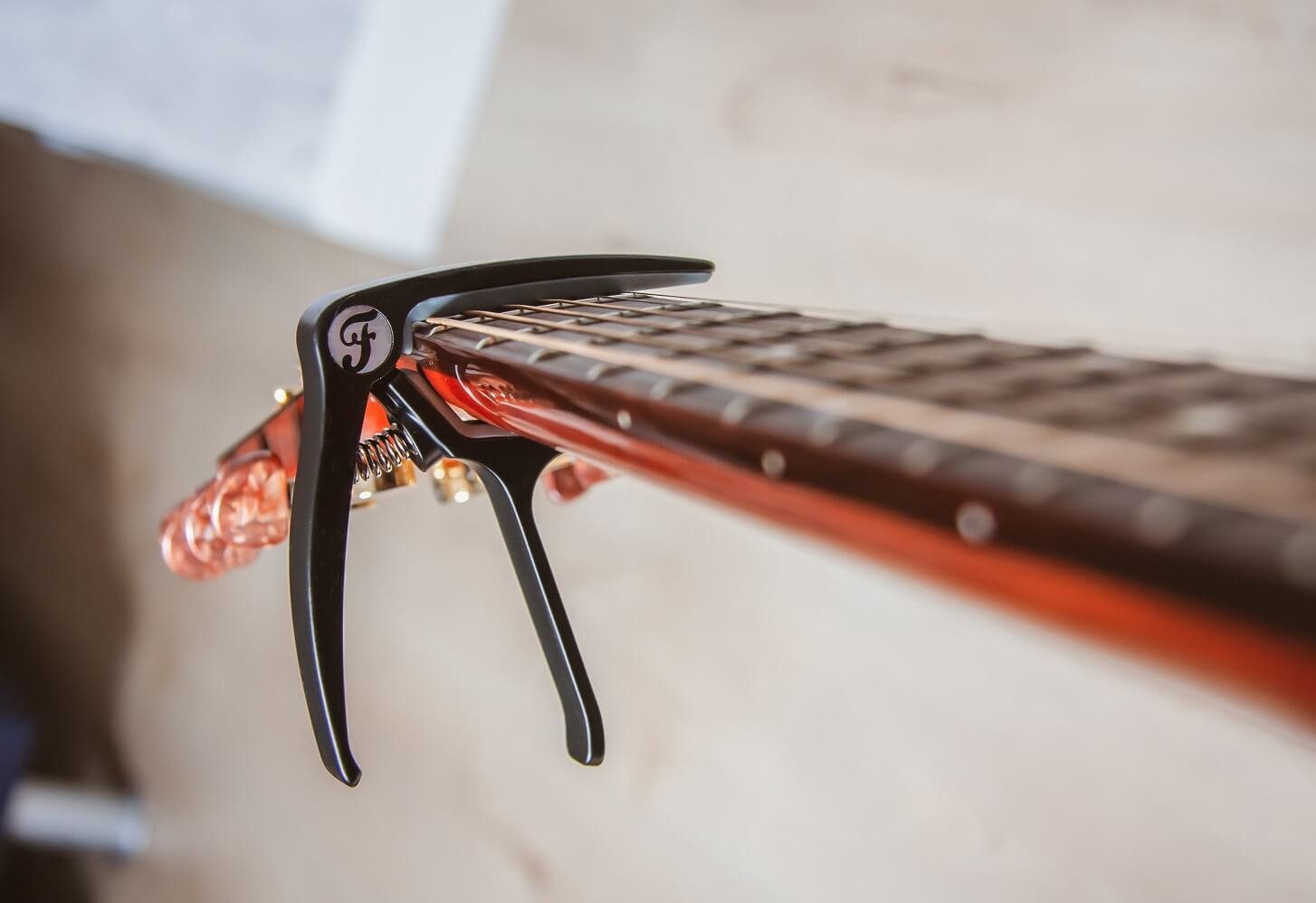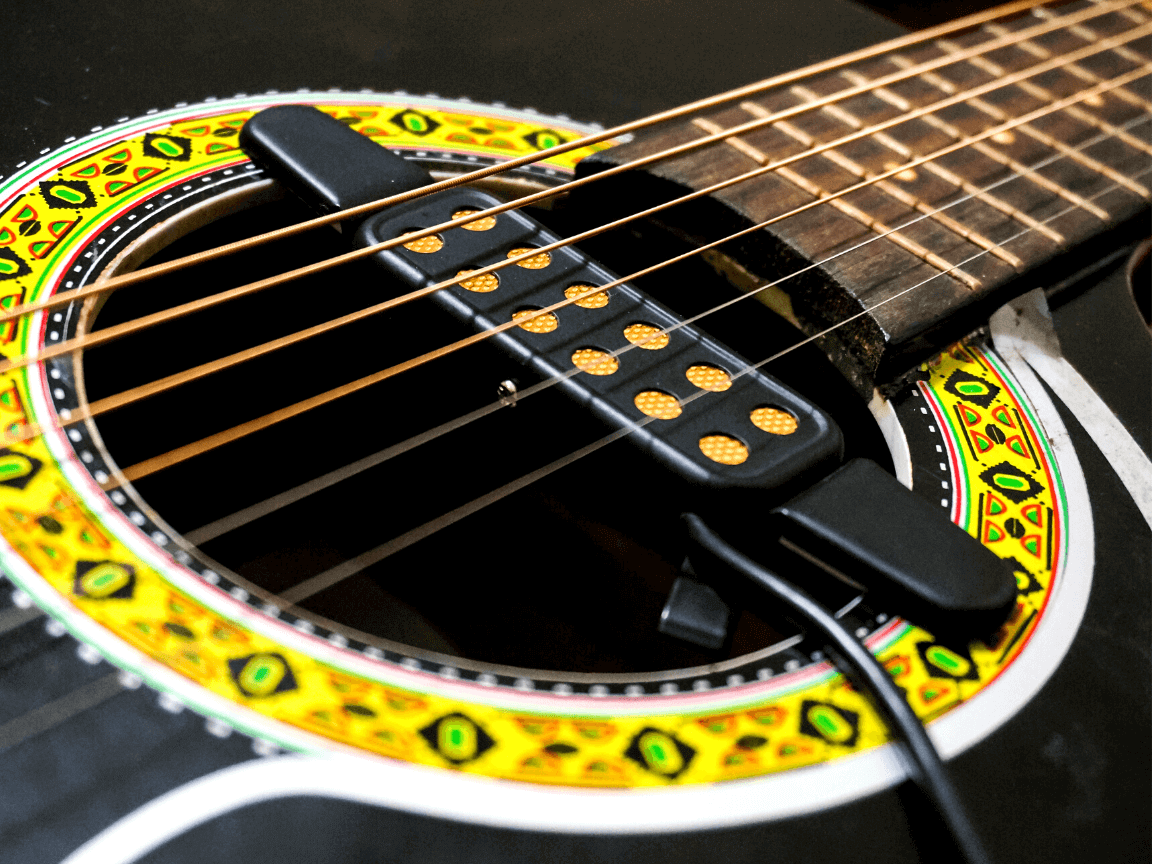In the world of guitar playing, there exist numerous factors that contribute to the overall sound and tone of the instrument.
One variable that is frequently overlooked is the guitar pick.
Indeed, the pick, despite its small size, can notably influence the sound generated by any guitar.
In this blog, we delve into the specifics of how a guitar pick affects the guitar’s tone, based on its material, thickness, and shape.
We’ll also examine how different picks may be more suitable for various musical styles.
Prepare to explore an overlooked but salient element in the quest for your perfect guitar tone.
Table of Contents
- Does A Guitar Pick Affect The Tone Of Your Guitar?
- The Impact of Guitar Pick Thickness on Tone
- Does a Larger Pick Size Affect Volume?
- Comparing Guitar Picks Made of Different Materials
- How Much Does the Shape of the Pick Matter?
- What to Expect When Switching Between Hard and Soft Picks?
- Textures of Guitar Picks and Their Influence on Sound
- Ideal Guitar Picks for Different Music Genres
- How Pick Grip Can Change Sound?
- Is There an ‘Ideal’ Guitar Pick for Tone?
- The Bottom Line
Does A Guitar Pick Affect The Tone Of Your Guitar?
Yes, a guitar pick does affect the tone of your guitar. The thickness, shape, and material of the pick can influence both the volume and the brightness of the sound produced. A heavier pick might give a louder and brighter tone, while a lighter one typically results in a softer and warmer tone.
Continuing with the subject of guitar picks, it’s important to note that the choice of a guitar pick is not just about the tone.
There are numerous other factors such as playability, comfort, and the style of music that you’re playing.
These elements also play a significant role in the selection of the perfect pick.
Understandably, these details might not appear as important at first glance, but through this article, we will delve into these aspects, transforming the way you perceive and utilize guitar picks in your musical journey.
Keep reading to garner deeper insights and establish a broader perception of guitar picks beyond just affecting the tone of your guitar.
The Impact of Guitar Pick Thickness on Tone
Have you ever wondered how the thickness of your guitar pick can influence the produced tone when you play your instrument?
This aspect may seem trivial on the surface.
However, a deeper understanding would reveal just how important and influential it is.
Guitarists of different levels of expertise often overlook the profound effect of pick thickness on the tone of their guitar.
– Understanding Pick Thickness
The thickness of a guitar pick is measured in millimeters (mm).
The range typically starts from extremely thin picks, often marked as ‘thin’, which can be less than 0.60mm to ‘extra heavy’ ones that go beyond 1.20mm.
Therefore, when we talk about pick thickness, we’re essentially discussing the dimension from the thinnest to the heaviest picks, and everything in between.
As a general rule, the thicker the pick you use, the fuller and warmer the tone is likely to be.
On the contrary, thinner picks tend to deliver a sharper, brighter tone.
– Reasons behind the Difference in Tones
The science behind this tells us that thicker plectrums vibrate less when they come in contact with the strings.
As a result, they produce relatively smooth and rounded tones.
However, thinner picks vibrate more, thereby causing a brighter and more treblish tone.
The choice of a guitar pick thickness directly affects the tone, giving the player options to express their music differently.
This statement emphasizes how much the thickness of a plectrum contributes to guitar sound.
With this in mind, guitarists can experiment to get the exact tone they are looking for.
Sometimes, this might mean trying different thicknesses to see which one suits their genre or style the best.
– The Role of Personal Preferences
Picking the right thickness is also a matter of personal comfort, as different players have distinct preferences.
Beginners usually prefer thinner picks because they are softer and easier to manipulate.
Conversely, more experienced players might go for thicker ones for a richer tone, despite making it somewhat more challenging to play fast.
It’s no exaggeration to state that the thickness of your guitar pick indeed has a significant impact on your guitar tone.
And while it may seem like a minor factor, it makes a noticeable difference in the sound produced by your instrument.
As we deepen our exploration of guitar picks, this video can give you more insight.
It can help you further understand the significance of pick thickness and other factors that you may want to consider when choosing a guitar pick.
Does a Larger Pick Size Affect Volume?
One of the primary considerations when choosing a guitar pick is its size.
Many guitarists may think that a larger pick would produce a louder sound, but is this really the case?
Let’s delve into this question and thoroughly explore how the size of a pick affects the volume of a guitar’s sound.
– Understanding Guitar Pick Size
The size of a guitar pick plays a crucial role in determining the comfort and playability for a guitarist.
Large guitar picks are typically easier to grip, which can make playing more comfortable, especially for beginners or those with larger hands.
They may also offer a larger surface area, providing more contact with the strings and potentially affecting the volume of the sound produced.
Despite common assumptions, a larger pick size does not directly correlate with increased volume.
In actuality, the impact on volume is more closely tied to the technique of the guitarist and the inherent resonant capabilities of the guitar itself, rather than the size of the pick.
A more skilled player may be able to extract a louder sound with a smaller pick than a novice with a larger pick, owing to their superior picking technique and string control.
– How Pick Thickness Impacts Volume
While the size of a pick may not significantly affect volume, the thickness of a pick does.
Generally speaking, thicker picks tend to produce a louder sound, because they hit the strings with more mass.
On the contrary, thinner picks are more flexible, strike the strings with less force, and so produce a softer sound.
Therefore, if volume is a priority, a guitarist might consider a thicker pick rather than a larger one.
Even though the size of the pick may not directly influence the output volume, selecting a larger or smaller pick could indirectly impact the volume depending on the guitarist’s comfort and proficiency with the pick.
For example, a guitarist who is more comfortable with a larger pick and can wield it more accurately might be able to generate a louder sound simply due to their increased confidence and control.
– Other Factors Impacting the Volume
Apart from the size of the pick, a variety of other factors can significantly affect the volume produced by a guitar.
These factors include the guitarist’s technique, the angle at which the pick strikes the strings, the position of the player’s hand, the type of guitar, and its setup (including elements like string gauge and action setup).
Therefore, it’s important not to overlook these other components when trying to increase your guitar’s volume.
A guitarist’s technique, including how they grip and use the pick, has a significant influence on the guitar’s volume.
Indeed, a player’s skill and experience can significantly affect how loud or soft their music is, regardless of the pick size they prefer.
So before changing to a larger pick size in hope of increasing the volume, guitarists should first evaluate their playing technique.
Improvements in technique and playing style can often have a more significant impact on volume than merely changing to a larger pick.
Comparing Guitar Picks Made of Different Materials
In the musical journey of a guitarist, the search for the perfect guitar pick may appear like a formidable task.
Beyond the shape and thickness, the material of the pick is a critical determinant of your guitar’s sound.
To explore this subject in-depth, let’s delve into the influences of different pick materials on the tone produced by a guitar.
– Plastic Picks
The most common and versatile type of picks used by guitarists are made from plastic.
Plastic picks come in a variety of forms including nylon, celluloid, and Delrin, each producing distinct tonal characteristics.
Nylon picks, for instance, are known to deliver a brighter and snappier sound, while celluloid picks produce warmer, fuller and more classic tones.
Delrin picks, on the other hand, provide a very balanced sound.
Hence, your choice of plastic pick material can greatly influence the tone of your guitar.
Plastic picks are generally favored by guitarists for their versatility, offering a broad range of tones and dynamics to explore.
A significant tonal variation can be introduced by simply switching between different types of plastic guitar picks.
Thus, if you desire to experiment with your guitar’s tone, trying out different plastic picks could be your first step.
Plastic picks also afford you the opportunity to play across different music genres, thus making them suitable for versatile guitarists.
– Metal Picks
Another category of picks are those made from metals such as brass and stainless steel.
Metal picks are recognized for their durability and sturdiness.
They produce a sharper and brighter tone compared to plastic picks, which makes them ideal for music styles that require a more clear-cut tone.
However, they can cause wear and tear on guitar strings if used over time, making these picks less desirable for some guitarists.
The use of metal picks introduces a unique clarity and brightness to the guitar’s tone.
Metal picks, while giving a distinct tonal quality, may cause string damage over time.
This points to the need to occasionally alternate them with other picks if you wish to extend the lifespan of your strings.
Yet the audio characteristics they bring make them potentially an alluring pick option for those looking for a brighter guitar tone.
Watch the embedded video to further understand how pick gauges can influence your performance.
This will not just enhance your understanding, but also guide you in making an informed choice about the kind of pick, including its material, that best suits your requirements.
– Wooden Picks
Wooden picks bring another flavor to guitar tones, known for producing warm and rounded tones.
They are available in a variety of wood types, such as rosewood, mahogany, maple, each having its unique tonal impact.
While they are generally more frail and expensive compared to other pick types, wooden picks are cherished by many guitarists for the unique and warm vibes they produce.
The use of wooden picks can offer a unique aural experience, bringing about warm and natural tonal quality.
Each type of pick, being it plastic, metal, or wood, comes with its unique attributes affecting the tone of your guitar.
Therefore, understanding these elements is crucial to tailor your guitar’s sound according to your preferences and playing style.
How Much Does the Shape of the Pick Matter?
At a basic level, most picks can be divided into three distinct parts: the tip, the body, and the grip.
These different parts can come in multiple shapes, thus providing a different experience when playing.
The tip of the pick plays an especially significant role in the sound production as it is the part that comes into direct contact with the strings.
Different tip shapes such as sharp, rounded, or pointed, can drastically impact the type of sound produced.
The grip and the body of the pick also play roles in the comfort and maneuverability while playing, indirectly affecting the overall output.
Different tip shapes such as sharp, rounded, or pointed, can drastically impact the type of sound produced.
This quote signifies that a pick’s shape can transform the sound drastically.
Therefore, understanding the impact of the shape on the sound can help guitarists make better choices when choosing a perfect pick.
A standard pick shape, also sometimes referred to as a ‘351 shape’, is teardrop-shaped, with a wide body and a sharp tip.
This shape is versatile, offering a good balance of control and versatility of sound.
On the other hand, a Jazz III pick has a small, sharp tip and a broad body, known for its precise control and bright sound output.
Triangular picks, those with three identical sides and points, offer different playing facets to experiment with.
Some musicians prefer sharkfin-shaped picks, known for their unique capability to create a variety of tonal effects.
Triangular picks, those with three identical sides and points, offer different playing facets to experiment with.
As shown, there are many shapes of guitar picks and each offers a distinct sound quality.
This diversity makes it possible for guitarists to find the perfect pick that matches their playing style and the sound they aim to produce.
It’s essential to note that beyond the sound effect, the shape of the pick can also influence the level of comfort for the player.
For example, picks with a larger surface area or a more prominent grip can be easier to hold.
On the contrary, smaller picks might provide more control – but may also require more finger exertion.
Therefore, the ideal pick shape might also depend on the player’s comfort, precision, and strumming style.
Overall, the shape of the pick doesn’t just affect the tone and volume; it also plays a vital role in the playing experience.
The ideal pick shape might also depend on the player’s comfort, precision, and strumming style.
This quote elucidates the importance of personal comfort and playing style in determining the right pick shape.
Thus, while exploring different pick shapes for their effect on sound, musicians should also consider their comfort and playing needs.
What to Expect When Switching Between Hard and Soft Picks?
Changing between hard and soft guitar picks can significantly affect the tone, control, volume, and playability of your guitar.
It’s important to understand the intrinsic differences between these two types of picks in order to maximize the potential of your instrument and playing.
Hard picks are usually made from thicker, more rigid materials such as celluloid, nylon, or even metal.
These materials allow for greater precision and control when hitting the strings, which can be beneficial for intricate solos or complex chord progressions.
Soft picks, on the other hand, are often made from flexible materials such as vinyl.
These picks offer more flexibility when strumming chords and can create a softer, mellower tone.
The softer material of these picks also tends to produce less string noise, which can be advantageous for certain styles of music.
Hard picks provide precision and control, while soft picks offer flexibility and a mellow tone.
This statement emphasizes the different attributes of hard and soft picks.
Choosing between the two typically depends on the genre of music you’re playing, your personal playing style, and your desired tone.
One of the most noticeable differences when switching between hard and soft picks is the change in volume and tone.
Hard picks often produce a louder, brighter tone due to the rigid material striking the strings with more force.
Soft picks, because of their flexibility, often create a quieter, warmer tone.
However, the volume can also be influenced by how hard the guitarist strums the strings, regardless of the pick’s hardness.
Thus, while the pick can influence the volume and tone, the guitarist’s technique also plays a significant role.
The rigidity of the pick can influence the volume and tone, but ultimately, the guitarist’s technique also plays a crucial role.
This statement underscores the impact of the guitarist’s technique on the volume and tone, reinforcing how the pick is only one piece of the puzzle.
This further highlights the importance of a musician truly understanding their instrument and how different components can influence the sound produced.
For a more visual explanation on how the hardness of guitar picks can affect sound, please watch this next video:
This will give you a clearer understanding of the differences in sound produced by hard and soft picks.
Furthermore, it will also provide you with practical demonstrations on the impact that different pick materials can have on your guitar’s sound.
Textures of Guitar Picks and Their Influence on Sound
Many guitarists underestimate the impactful role guitar pick textures play in shaping their sound quality.
Not only does texture affect the grip of the pick, but it also influences the overall tone of the guitar.
– Grip and Comfort
Textured guitar picks are strategically designed to deliver a more secure grip, reducing chances of the pick slipping from your hand mid-performance or practice.
This enhanced level of comfort and control can subsequently translate into smoother riffs and more confident performances.
Guitarists using smoother picks might find themselves occasionally readjusting their grip – which can lead to inconsistency in their playing.
The texture of a guitar pick greatly influences its grip, playing a crucial part in the guitarist’s comfort and control over the instrument.
Highly-textured picks promote consistent contact with the strings, thereby ensuring a reliable sound.
They can be particularly beneficial for those with sweaty hands, providing the extra traction needed to prevent the pick from slipping.
– Tone and Attack
Beyond comfort and grip enhancement, textured guitar picks also significantly affect the sound production of your instrument.
The additional friction generated between the textured pick and guitar strings creates a more pronounced, aggressive attack – usually resulting in a brighter tone.
Artists seeking to showcase a harder, heavier sound might, therefore, appreciate the textural intricacies of these guitar picks.
Textured picks add an extra layer of friction which generally produces a brighter, more aggressive tone, suitable for heavy genres.
Every guitar pick design yields a unique tone, with texture playing a pivotal role in defining the resulting sound characteristics.
May it be a grungy rock look or a soft jazz tune, the texture gives each style its distinctive sound.
– Variety of Textures
There’s a vast selection of guitar pick textures available today, with options ranging from gritty to super smooth.
Most commonly, guitarists come across picks featuring raised lettering, ridges, or bumps – these textured designs aim to enhance grip and add a unique aesthetic appearing to the pick.
Your choice from the range of these textures can dramatically shape your sonic output, articulating different levels of attack and richness in tone.
The market offers everything from slick, smooth picks to heavily textured ones, each contributing its unique characteristics to the sound produced.
Choosing the right texture ultimately boils down to personal preference and the type of sound you aim to create.
For the individualized artistry of each guitarist, the texture selection gives them an opportunity to experiment and discover their preferred sound.
Despite seeming like a minor aspect of guitar playing, the texture of a guitar pick holds a notable influence on both the playability and tone of the instrument.
Therefore, exploring different pick textures can be a rewarding endeavor in your path to refine your personal sound signature.
Ideal Guitar Picks for Different Music Genres
The concept of ideal guitar picks in relevance to different music genres greatly varies as it very much depends on the kind of tone, volume and expression that a musician endeavors to bring forth.
Each music genre requires a specific sound and tone, thereby considerably affecting the choice of guitar picks.
– The Rock Genre and Preferred Picks
When considering the rock genre, typically, heavier picks (with the thickness ranging more than 0.73mm) are the most preferred options.
They offer greater precision for fast-paced rhythms and lead-guitar parts, crucial in rock performances.
The reduced flexibility of these heavy picks allows better control over the guitar’s strings, which of course, is ideal for executing aggressive rock tunes.
Different music genres call for varying guitar pick weights and thicknesses to extract the desired sound and musical expression.
This concept is reinforced by the need for a heavier guitar pick to function better for rock music, as it provides the tight control and aggressiveness integral to the genre.
Not only do they offer the needed precision, but they also allow for a greater dynamic range due to their rigidity.
– Acoustic and Folk Music: What’s Ideal?
Moving onto more gentle music genres like acoustic and folk music, thinner picks go along quite well.
These genres typically demand pleasing, layered strumming and thus, lighter picks (ranging between 0.50 and 0.73mm) are the preferred choices.
The flexibility of these thinner picks aids in a smoother, softer transition between strings, essentially providing a mellow sound suitable for acoustic and folk music arrangements.
For laid-back genres like acoustic and folk music, thinner picks, due to their flexibility, help provide a softer and mellower sound.
This makes them optimal for genres centered on relaxed and fluid rhythms.
They also help bring out a warmer tone from the guitar, thereby enhancing the overall musical ambience.
– Jazz Music and Corresponding Guitar Picks
For jazz musicians, smaller and thicker picks are the preferred choice.
These types of picks offer the dexterity and control needed by the guitarist to execute complex chords and scales distinctive of jazz music.
Jazz picks are often heavier (more than 1mm), with a sharp tip to allow crisp, clear notes, critical to jazzy arrangements.
For jazz music, thicker, smaller picks with sharp tips are the recommended option to facilitate the complex musical runs and clearer, sharp notes pivotal for the genre.
Again, each genre has its specific needs and demand, thereby making the choice of guitar pick an incredibly subjective decision.
Various factors, such as a genre’s characteristic sound, playing style, and tonal preferences, influence this choice, making it all a part of the guitarist’s artistic representation.
By watching this, beginners or intermediate players can get a better understanding of the difference the right guitar pick can make in sound production.
In addition, it could also help experienced players fine-tune their guitar pick selection according to the relevant music genre.
How Pick Grip Can Change Sound?
When playing the guitar, every little detail matters and can have a significant impact on the sound that the instrument produces.
One of these details is the guitar pick, and specifically, how you grip it.
– The Importance of Pick Grip
Grip is often overlooked, but it plays an essential role in the final outcome of your guitar playing.
When you hold the pick too loose, you risk losing control and precision, while holding it too tight can result in a harsh and forceful sound that may not be desirable.
Grip also affects your playing speed and affects the note’s attack, which is how quickly the note reaches full volume after it’s played.
The way you grip your pick can significantly alter the sound and style of your tunes.
This is because different grip styles vary in terms of how much of the pick is exposed and how the pick strikes the strings.
It’s also important to remember that varying your grip during a performance can provide a wider tonal palette to draw from.
– Exploring Different Pick Grip Techniques
There are several grip techniques every guitar player should explore, as they greatly influence the overall sound of the guitar.
For instance, gripping the pick closer to its edge can produce a softer, rounded tone, while holding it at the middle makes the tone slightly more pointed and aggressive.
In particular, altering the angle at which the pick hits the strings (the pick slant) can create different tones and effects.
In the video above, you will find a clear demonstration of how pick grip can change the sound of your guitar.
It’s an excellent resource for those wanting an audible example of this concept.
– The Role of Practice
No matter what pick or grip style you use, it’s important to remember that practice is the key.
Like any skill, mastering different pick grip techniques and understanding how these can change your guitar’s sound takes time and patience.
Each player has their unique approach to their pick grip style that complements their identity as an artist.
This means you should not only practice but also experiment with different techniques until you find what sounds best for your playing style and the music you want to create.
Remember that there’s no right or wrong way, just different sounds for different styles.
Is There an ‘Ideal’ Guitar Pick for Tone?
When it comes to achieving the desired tone on a guitar, the choice of pick can play a significant role.
While personal preference undoubtedly comes into play, understanding the impact of different variables can guide musicians in their quest for that perfect sound.
– Exploring Guitar Pick Materials
A guitar pick’s material can be a crucial variable in establishing the tone.
For instance, hard materials such as metal or bone typically produce brighter, clearer tones compared to softer materials like nylon or felt.
However, softer materials can offer a warmer, mellow sound that is often sought for certain musical genres.
Understanding these material differences enables musicians to manipulate their tone based on pick selection.
Thus, for a musician who prefers a brighter, cleaner tone, a metal pick might be ideal.
On the contrary, a nylon pick may be best for those who favor a warmer, softer sound.
– Influence of Pick Thickness
The thickness of a guitar pick also plays a key role in tone production.
Thinner picks, being more flexible, generally produce a lighter, softer tone.
Whereas, thicker picks, due to their rigidity, are known for a heavier, darker sound quality.
Again, the thickness should be chosen in alignment with musicians’ preference for the tone they desire.
Choosing the right pick thickness can dramatically influence the tone of a guitar.
So, depending on your preferred tonal quality, the thickness of the pick can serve as crucial criteria in achieving your ideal tone.
Thinner picks could be the way to go for those seeking a softer, more mellow sound.
Conversely, thicker picks can offer a robust, dark sound for those after a heavier tone.
– Considering Pick Shape
The shape of the pick can impact the tone as well.
Sharper, more pointed picks allow for precise picking and generally deliver a brighter tone, whereas rounded picks generate a smoother, softer sound.
So, pick shape becomes yet another tool for the musician to use in manipulating their guitar’s tone.
The shape of a guitar pick can substantially affect the brightness or softness of a guitar’s tone.
Hence, sharper picks might be perfect for those who prioritize precision and brightness in their tone.
However, for those who desire a smoother, softer tonal quality, rounded picks could be the right choice.
While there might not be a ‘one-size-fits-all’ pick, each guitarist can find their ‘ideal’ pick by considering factors such as the pick’s material, thickness, and shape.
Personal preference should guide these considerations, keeping in mind the desired tone quality, genre of music, and playing style.
The Bottom Line
Drawing everything together, the myriad factors that influence the tone and volume of a guitar such as pick thickness, size, material, shape, flexibility, texture, and grip reflect the uniqueness of each guitarist’s requirements and preferences.
Though the partnership between guitarist and pick can impact techniques such as muting and palm muting, it is the role of the musician to choose their pick according to their desired sound and style of music.
There is no ‘one size fits all’ when it comes to picks, hence, the ‘ideal’ pick for tone vastly differs based on the individual.
Ultimately, it is the examination, exploration, and experimentation of these various elements that will guide a guitarist to their perfect pick.

Dad, husband, son, and guitarist. I’ve been playing guitar for 20 years. Passion for writing, painting, and photography. I love exploring nature, and spending time with my family. Currently have a Gretsch G5220 Electric Guitar as my main instrument.




